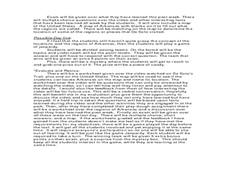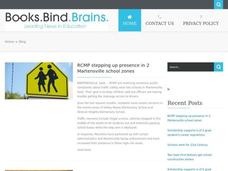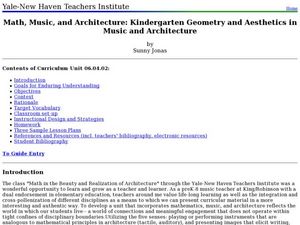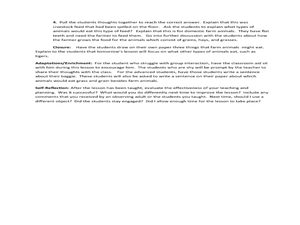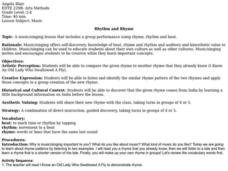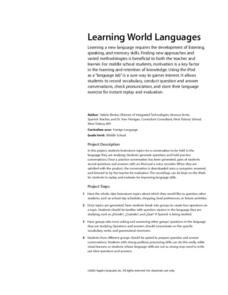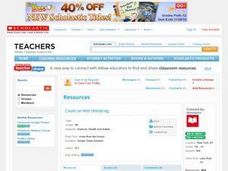Curated OER
Arkansas History Lesson Plant One: Play-Do Soto
Fifth graders complete a variety of projects to learn about Arkansas history. In this Arkansas lesson plan, 5th graders go on a field trip to a state park, explore an Arkansas map, put play-dough on the trail of De Soto, color regions of...
Curated OER
Needs and Wants
First graders recognize the difference between needs and wants. In this treaty instructional activity, 1st graders chart their needs and wants to be used in making a treaty. Students negotiate what should be in the treaty based on the...
Curated OER
Governance
First graders make connections between the purposes of rules. In this governing lesson students listen to a story about rules being broken. Students identify rules that they have at school or home.
Curated OER
Math, Music and Architecture: Kindergarten Geometry and Aesthetics in Music and Architecture
Students identify and name different geometrical shapes. In this math lesson, students distinguish odd from even numbers. They describe the properties of 2 and 3 dimensional objects.
Curated OER
The French Revolution
French Revolution lessons can help students explore the political, social, and economic issues of the time.
Curated OER
What's in it and Who Eats it?
First graders explore farming by illustrating images. In this livestock activity, 1st graders discuss what types of plants are used to feed livestock animals and how pets and humans eat the livestock animals. Students draw images of what...
Curated OER
Tradition through storytelling and music
Students discover how storytelling can shape a person's tradition.Students examine different methods of storytelling such as music, biographies, and African folktales. They then demonstrate their knowledge of storytelling by writing...
Curated OER
Learning to Summarize a Story
Students with hearing loss read independently and understand what is being read to them. In this independent reading lesson plan, students sequence and discuss the book that is read.
Curated OER
Inference Lesson Plan
Students practice assessing graphics to infer and identify an author's implicit and explicit meaning in a piece of text. They evaluate the effectiveness of information found in maps, charts, tables, graphs, diagrams, cutaways and through...
Curated OER
Investing in Early America Game: Early Industrial, Transportation, and Communications Revolution
Students review pages in the text to find out what was happening in each of the areas. They use the "Investment Opportunities Game Sheet" to record their investments, assume an investor identity, which influence how they choose to invest...
Curated OER
How Do You Learn Best?
In this learning styles activity, students, with a partner, take a quiz on how they learn best and discuss what intelligences and multiple intelligences mean.
Curated OER
Come Fly with Me
Students identify rhyming words from the book A Fly Went By by matching words written on index card with same endings, eliciting word when prompted by teacher, and by identifying rhyming words in the text.
Curated OER
Rhythm and Rhyme
Young scholars compare the given rhyme to another rhyme that they already know (I Know An Old Lady Who Swallowed A Fly). Students listen and identify the similar rhyme pattern of the two rhymes and apply those concepts to a group...
Curated OER
Rhythm and Rhyme
Students listen to and identify the similar rhyme pattern of two rhymes and apply those concepts to a group creation of a new rhyme. They discover that the given rhyme comes from India by learning a little background information on India.
Curated OER
Many Uses of the Forest
First graders examine pictures of forest wildlife and identify different animals that live in the forest. They discuss resources the forest provides for human use and explore the concept that the forest is used by many at the same time.
Curated OER
Constitution Cartoons
Young scholars view series of cartoon overheads that explain Constitution, name branches of government and their powers, define federalism and separation of powers, examine rights and obligations of citizens, and discuss significance of...
Curated OER
Composing Project
Students design, compose, and present short musical compositions for keyboard in this lesson plan meant for the high school choir class. This lesson can be adapted to any time frame, but the author suggests a considerable amount of time...
Curated OER
Learning World Languages
Students brainstorm topics for a conversation to be held in the language they are studying. They generate questions and hold practice conversations. Pupils record question and answers with an iPod and a voice recorder. When they are...
Curated OER
Count on Wet Ones??
Students listen to fingerplay songs, clean hands with Wet Ones wipe or squirt of hand sanitizer, sing Five Little Monkeys Jumping on the Bed, discuss what would happen if monkeys were germs on their hands, and use their hands and...
Curated OER
Technology that Makes Phonics Fun
Students discover the Internet by participating in on-line educational activities. In this educational technology lesson, students utilize interactive story books, podcasts, and games to help expand an understanding of phonics....
Curated OER
Paul Revere's Ride-Fact or Fiction?
Students discuss Paul Revere's ride. In this social studies lesson, students read Paul Revere's Ride and compare the differences between the poem and the historical event.
Curated OER
What is Money? Learn the Role of Money in a Free Market System
Pupils view a seashell and listen as the teacher explains that these were sometimes used as money. They listen as the teacher lectures on medium of exchange, barter, and commodity. Students determine the number of chickens it would take...
Curated OER
All About Titan and the Huygens Probe
Students examine the characterisitics of Saturn's largest moon, Titan. They discuss what they think is on Titan and what the Huygens probe can tell them about the moon. They write a summary about the information they gathered during...
Curated OER
Introduction of Primary Sources
First graders examine a database to explain the use of primary source documents.


